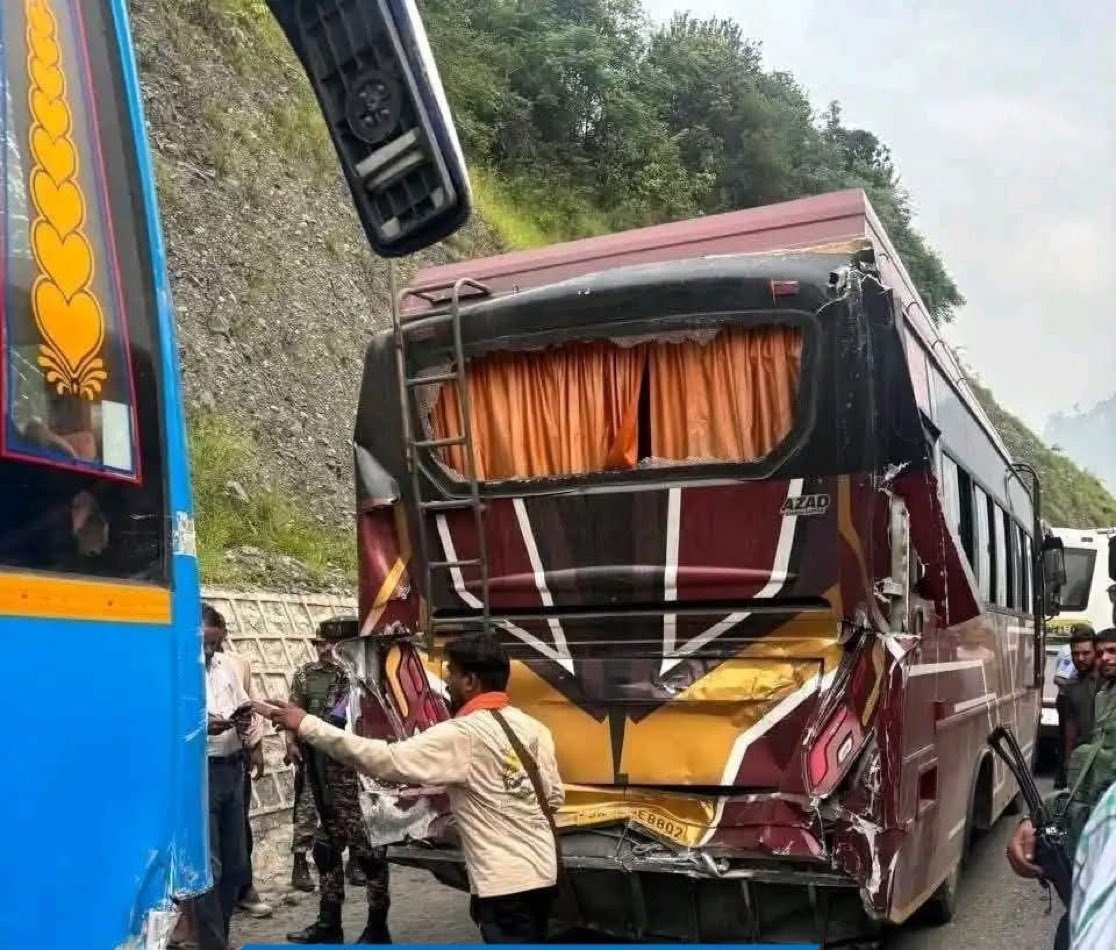36 Amarnath Yatra Pilgrims Injured in Ramban Bus Collision | Brake Failure on Jammu-Srinagar Highway
By: Javid Amin | Srinagar | 05 July 2025
A Narrow Escape Amid Devotion
On the morning of July 5, 2025, devotion met danger on the winding roads of Jammu and Kashmir’s Ramban district. A convoy of five buses carrying pilgrims en route to the Amarnath cave shrine collided near the Chanderkote langar site, injuring 36 pilgrims. The cause: a suspected brake failure in the last vehicle of the convoy.
While all injuries were thankfully minor, the accident has raised fresh concerns about road safety, logistics, and emergency preparedness during the Amarnath Yatra, one of India’s most spiritually significant and logistically complex pilgrimages.
The Collision – What Exactly Happened?
Around 8:00 AM, on the Jammu-Srinagar National Highway, five buses carrying Amarnath Yatra pilgrims were parked at a langar (community kitchen) site in Chanderkote. According to eyewitnesses and traffic officials, the last bus in the convoy lost control due to brake failure and crashed into the stationary buses ahead.
Key Details:
- The accident occurred near Chanderkote, a known stopover for langars and rest.
- Initial reports suggest a mechanical failure, but further inspection is ongoing.
- The buses belonged to a registered pilgrimage service fleet.
Emergency Response – Rapid, Coordinated, Effective
Within minutes of the accident, local authorities, police, and healthcare teams were on the scene. The prompt action by District Commissioner Mohammad Alyas Khan, along with paramedics and highway patrol, ensured swift triage and evacuation of the injured.
Response Highlights:
- All 36 injured pilgrims received first aid on site before being shifted to Ramban District Hospital.
- No critical injuries were reported, and most patients were discharged the same day.
- The injured pilgrims were re-accommodated in alternate buses to continue their yatra.
This seamless response is a testament to the multi-agency coordination prepared for the Yatra’s emergencies.
Yatra Logistics Under Strain – A Cautionary Episode
The Amarnath Yatra 2025, which began on July 2, has already seen over 30,000 pilgrims make the journey to the sacred cave. With thousands more expected daily, managing traffic, accommodation, food, medical needs, and weather unpredictability is a Herculean task.
This accident underscores two critical issues:
- Mechanical Fitness of Vehicles: Pilgrim buses must undergo rigorous technical checks, especially when navigating steep mountain terrain.
- Convoy Movement Protocols: Ensuring proper spacing, speed regulation, and monitoring brake systems can prevent future collisions.
The accident acts as a stress test for the preparedness of state machinery, and while this incident was handled efficiently, it is a reminder of the unpredictable nature of road travel in hilly terrain.
Voices from the Ground – Pilgrims and Officials Speak
While there were no fatalities, the emotional impact on the pilgrims was evident. Many expressed gratitude for surviving the mishap and praised the quick response of the local administration.
“We were so scared. One minute we were praying at the langar site, the next we heard a loud crash,” said Meena Sharma, a pilgrim from Uttar Pradesh. “But the police and doctors came so quickly—we felt taken care of.”
Deputy Commissioner Mohammad Alyas Khan stated:
“Our priority is always the safety and well-being of every yatri. This was an unfortunate mechanical failure, but our response was immediate. We are reviewing convoy protocols to prevent future incidents.”
Infrastructure and Risk on the Jammu-Srinagar Highway
The Jammu-Srinagar National Highway is a lifeline not just for pilgrims but for Kashmir’s entire supply chain. However, the road is known for its landslides, narrow bends, and unpredictable weather, making any mishap potentially deadly.
Risk Factors:
- Brake overheating on steep descents
- Poor road visibility in monsoon months
- Inadequate signage in high-traffic stretches
Despite multiple upgradations, the highway remains vulnerable. More needs to be done in terms of:
- Real-time vehicle monitoring
- Mandatory rest stops for mechanical checks
- Training drivers for mountain road safety
Broader Implications – Pilgrimage Safety as a National Priority
Incidents like this are not just local administrative issues; they touch upon national questions of public safety, religious freedom, and infrastructure readiness.
What Can Be Done:
- Pre-departure mechanical fitness certification for all vehicles in the Yatra convoy.
- Insurance coverage and medical SOPs for all pilgrims.
- 24×7 highway medical units at every 15 km stretch during peak Yatra dates.
- Driver fatigue management systems using GPS and wearable monitors.
With more than 4 lakh pilgrims expected this year, every glitch in the system can impact lives and national headlines.
Looking Ahead – Lessons for the Remaining Yatra Days
The Amarnath Yatra will continue till August 19, and this accident, though not fatal, serves as a wake-up call. The upcoming weeks must see:
- Tighter convoy discipline
- Increased vehicle scrutiny checkpoints
- Community awareness campaigns for pilgrims on basic road safety
A Resilient Journey
Despite the accident, pilgrims have shown immense faith and resilience. Their journey is not only a spiritual odyssey but also a test of endurance, logistics, and faith in public systems.
As one yatri put it:
“This is Baba Barfani’s blessing. We are okay, and we will complete our yatra with even more devotion.”
Bottom-Line: From Crisis to Caution – Strengthening the Pilgrimage Path
The Ramban accident, though non-fatal, is a sobering moment in the grand narrative of Amarnath Yatra 2025. It highlights the thin line between spiritual bliss and logistical chaos. With proper coordination, vehicle management, and timely intervention, tragedies can be averted.
Let this incident serve not as a deterrent, but as an urgent call for better planning, accountability, and pilgrimage safety—ensuring that faith can flow freely, but safely, through Kashmir’s mountains.

